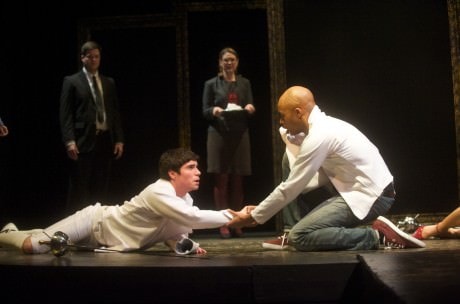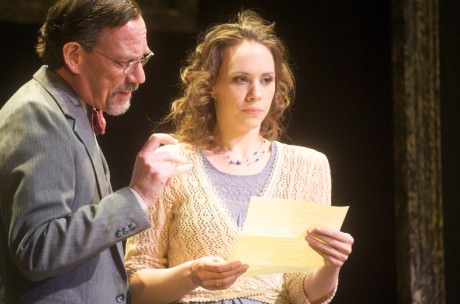Since brevity is the soul of wit, I will be brief. Annapolis Shakespeare Company has mounted to the stage, for their first offering of 2014, Shakespeare’s noble tragedy: Hamlet. Directed by Sally Boyett, the production comes with a slightly modern focus; all the costumes bringing the production to an indeterminate location in the present day. Performing the tragedy with haste, subtle edits have been adapted to keep the otherwise lengthy play in check and to a more suitable running time for younger audiences.

Creating an edgy modern look for these Danish characters is achieved by the works of Costume Designer Maggie Cason. Slick blazers for the men, aristocratic fitted dresses for Gertrude; and black suits for members of the night watch; all create a modern business-like appearance for this production. Cason’s intentional lack of color in the wardrobe choices lets a cloud of melancholic doom hover over the production while simultaneously making outfits that do feature color— like the treacherous and sinful red of Gertrude’s party gown— pop out against the darkened palette of the stage.
Crafting an unusual yet surreal set, Director Sally Boyett creates silhouette boxes from enormous hanging gold gilded picture frames. A matching thrust of golden marbled pattern juts out three rows into the audience, forcing the action and emotion of Hamlet’s soliloquies right into the audience’s lap. Boyett’s use of this frames to create frozen moments of unspoken action is a mix of success and failure. Large groups of people emerge from these photo frames prior to a scene starting, like the characters were walking into the play from a still life and this is a fascinating framework for the show. But there are other moments where Boyett employs the use of the framework— mainly during quick scene changes with Ophelia caught in shadowy lighting doing some sort of interpretive movement— that do not work as well and feel superfluous and confusing to the show overall.
Boyett highlights minutia of modern times with an exceptional knack for doing so throughout the performance. Ophelia finding a small dose of drugs in Laertes bag as he packs and departs, or Polonius handing over his credit card to Laertes while delivering the ‘borrower nor lender’ speech are all subtle yet intricately woven gestures that speak to the modernization of the production. Carrying guns rather than rapiers but choosing to still present the final duel between Hamlet and Laertes as a fencing competition is another example of the balance Boyett finds in the performance, blending modern references with the authenticity of the original text.
There are moments that because of the heightened pace simply do not work with the edits brought into the script. When Horatio reads the letter that Rosencrantz and Guildenstern have been dispatched, the pair appear so briefly in such dim shadow that you almost can’t see the blindfold upon their eyes, and the gunshot sound effect occurs with a delay, riding overtop the entrance to the next scene. Ophelia’s constant silent appearances with interpretive movement in the silhouetted portraits are other moments that because of their brevity just don’t work as a whole.
Fight Director Paul Edward Hope keeps the action fully functioning at a tightened and believable pace. The heinous abuse that comes down between Ophelia and Hamlet during their confrontation scene is played out with frightening exception thanks to Hope’s sharpened skill. The fencing has excellent technique between Laertes and Hamlet in the final showdown; agile and nimble blows that devolve into a physical fight sans foils; a bold but well-received move.
The acting on the whole is strong; a few characters here and there lacking decisive motivation or direction for their character’s emotions. This happens mainly with Claudius (Paul Edward Hope) and Gertrude (Nafeesa Monroe). Hope gives a harrowing delivery as the Ghost of Hamlet’s father; a fascinatingly symbolic choice made by Boyett to double cast him in both roles. But as Claudius his expressions are limited in a sense that leaves his character feeling lacking rather than restrained. Monroe has a similar issue when creating depth with her character and achieving a feeling behind her loud outbursts, but her emotional breakdown with Hamlet in the bedroom confrontation is impressive. Both Hope and Monroe feed a subtle loving chemistry between them; a sinful relationship actualized with love rather than convenience.
Ophelia (Audrey Bertaux) is emotionally disturbed and plays every emotion to a heightened frenzied state. Bertaux often pushes her explosions too far, needing to reel them in just slightly so that when she has her final maddening outbreak it has someplace to grow to. Her madness is every present, seeping in from the periphery like a slow flood that fills her character to the brim and bursts through the dam of her continence without hesitation. The physicality that Bertaux imbues the poor girl with is haunting to watch as the madness consumes her body; a true understanding of how a delicate flower can be consumed from the inside out by a cankerous malady of the mind. Possessed by a reckless abandon; Bertaux delivers her final scene in the clutches of true delirium; a stunning moment to behold.
Taking on the role of Polonius, George Page crafts a simplistic approach to the advisory position. While at times a bit monotone this suits the character with his rich voice and steady delivery. Doubling up as the gravedigger, Page sports a Russian accent and uses it to change his cadence in a manner which favors comic timing; ensuring each of the puns and jokes crafted into those lines are delivered and land to the audience’s ear. That scene starts off with a moment of high amusement as his assistant, Ben Lauer, jams out to his iPod and ear buds, again referencing the modern time frame.
Giving one of the most remarkable performances of the production is Laertes (Sèamus Miller.) While he spends most of the time away and off-stage, when Miller returns to the news of Polonius’ death; the rage that surges forth from his is unbelievable. His body trembles with the full scope of his vengeful rage; the instability of his character’s mental state at that point so wildly fuming that it is terrifying to look upon. Miller delivers a flawless recital of his forceful speech in that moment, every word laced heavy with a plethora of angered emotions. His final moments on stage are delivered with equal tenacity and ferocity though the emotional scope is far different.

What a piece of work is Hamlet (Manu Kumasi.) A flurrying whirlwind of passions, maladies, emotions, and confusions, all drawn together in one performance given by Kumasi. A versatile and dynamic performer, Kumasi presents the Danish Prince as a dodecahedron; presenting a dozen different faces one for each person, encounter, or soliloquy. Following cues of passion, Kumasi leaps into each moment unafraid and emotional guns ablaze. Most of soliloquies are delivered in distracted starts; as if each beat within the text is a different emotional demon that does possess him, one surfacing on top of the other, all fighting for control of his character. Kumasi blends dark comedies with disturbing woe in his character’s delivery; possessing a frenetic energy that keeps his character in perpetual motion even in moments of physical and verbal stillness.
To see Annapolis Shakespeare Company’s Hamlet in this fashion is to understand the core concepts of Shakespeare without a great deal of excess to weigh down the plot. It’s a fascinating production worth glancing if the tragedies do tickle your fancy.
Running Time: Approximately 2 hours and 30 minutes, with one intermission.
Hamlet plays through April 13, 2014 through Annapolis Shakespeare Company at The Bowie Playhouse— White Marsh Park Drive in Bowie, MD. For tickets, call the box office at (410) 415-3513 or purchase them online.
LINKS
Meet the Director and Cast of ‘Hamlet’ at Annapolis Shakespeare Company: Part 1: Manu Kumasi.
Meet the Director and Cast of ‘Hamlet’ at Annapolis Shakespeare Company: Part 2: Audrey Bertaux.
Meet the Director and Cast of ‘Hamlet’ at Annapolis Shakespeare Company: Part 3: Paul E. Hope.





